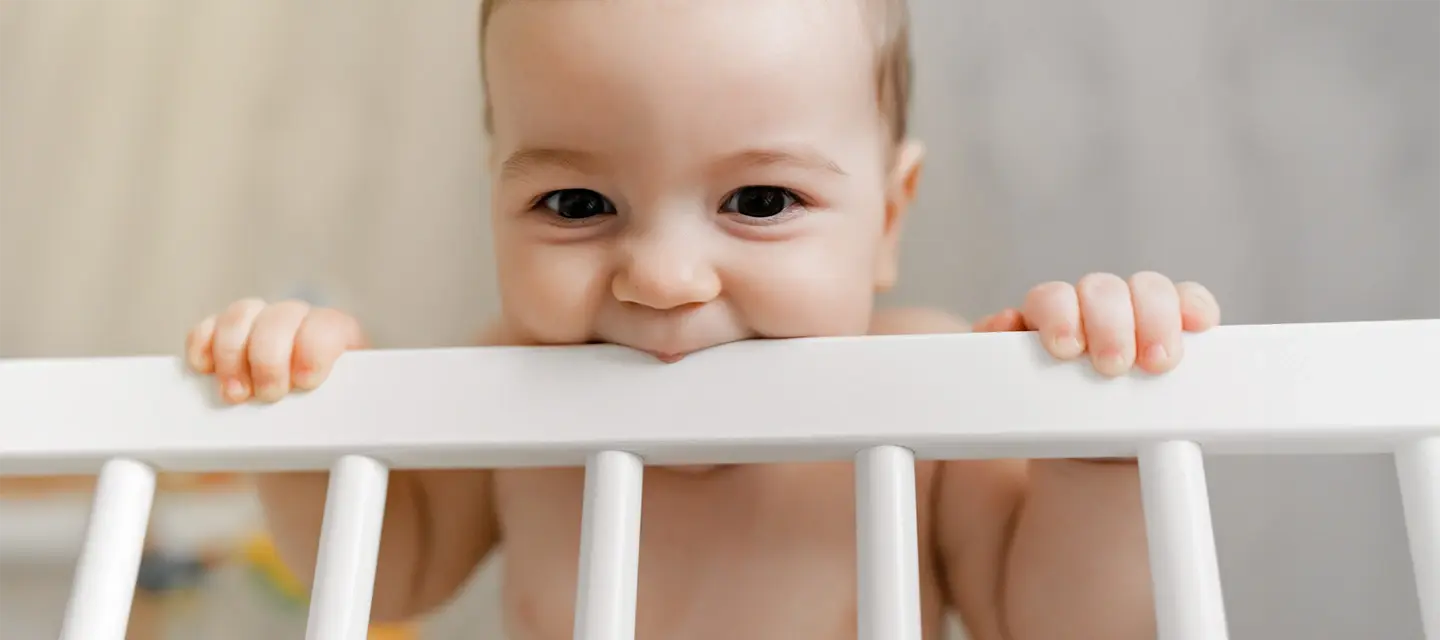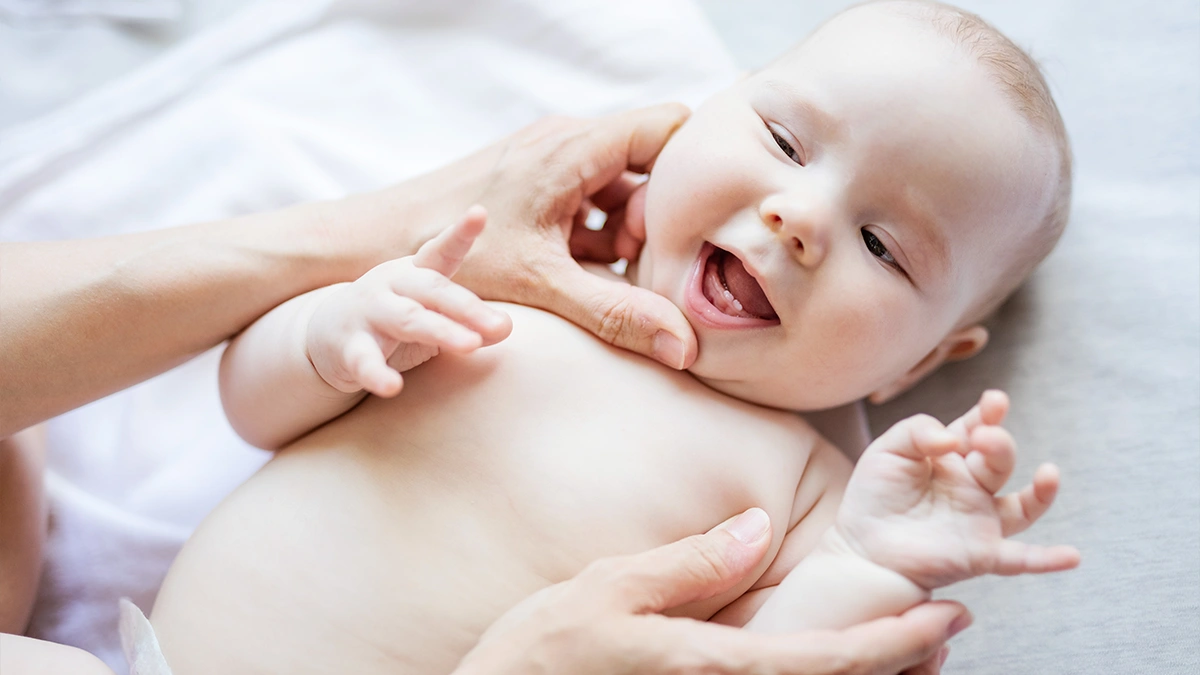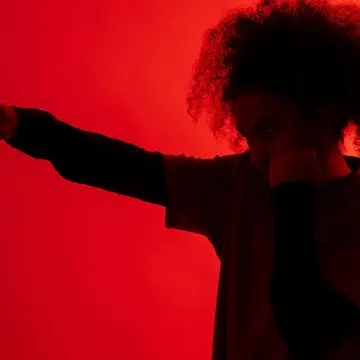11 min read
Surviving Baby Teething: Symptoms and Relief for Teething Blisters

Once upon a time, there was this mother who was not in pain watching her baby in pain. No, there wasn’t. Isolated parents everywhere, already a bit raggedy and frayed at the edges from the sleepless nights and insane amount of responsibility for something that used to take a village, are bound to face a new phase to test their resilience. The teething baby! There’s nothing quite like the bittersweet joy of watching your baby grow and their little faces showing traces of the future grown-up you’ll be honored to have raised (and muttered swear words at as you cried in the shower for emotional release).
All seems to be going well, schedules are finally falling into place, and then those tiny shark teeth decide to erupt with all the subtlety of a relentless caffeinated badger. Welcome to the teething dome, one of babyhood’s most talked-about rites of passage and an extreme sport for crying-maddened parents trying to provide relief. Is it messy? Yes. Confusing? Totally? Uncomfortable? You bet. Manageable? Absolutely—with the basic understanding of what is happening and when, a good freezer, some patience, and chewing tools, and a clean finger or two.
Whether you’re barely keeping your eyes open Googling blood blister on baby gums during a fortunately timed nap, squinting at normal baby gums vs teething gums, or are on a determined hunt for home remedies for teething baby at night, this is your by-the-bootstraps guide through the drool-soaked world of teething, resting on the guidance of the American Dental Association (ADA). Let’s go.
What is teething, and when does it start?
Teething is the (quite appropriate) name for the process of your baby’s first set of teeth (primary teeth) breaking through the gums. There is no definite set time for teething. It will mostly begin somewhere in the long long span between 6 and 12 months, but some babies are early bloomers and others take their time—that’s perfectly normal, and no reason to panic if yours falls a bit outside the curve.
Teething means pain, discomfort, crying, fussing, chewing, and drooling (more than usual). Pain is a life and a cultural universal. It cannot be reasoned, cuddled, or shushed away (although hugs surprisingly do have some analgesic effect,) and it needs to be relieved with gentle, safe remedies and some savvy product developed specifically for this purpose.

Baby Teething Safety
Manufactured items and old wives' tales alike, not all remedies are created equal. Safety comes first, and it’s better to be uncomfortable for a while than seriously injured. What should one be mindful of?
- No-no to benzocaine gels: Logic and medicine suggest that if something is painful and uncomfortable, numb it out, and voilà. This is why the market has developed various topical numbing agents, such as benzocaine gels. The FDA is not so happy with this and warns parents not to use it in children under 2, as there is a risk of some side effects, a more serious one being methemoglobinemia. This is a rare but serious condition that limits oxygen in the blood. No matter how rare, the fact that it is possible should be enough to deter you when there are safer options available for the same effect.
- Skip amber teething necklaces: The premise behind amber teething necklaces (usually made from Baltic amber) is that they release succinic acid that provides relief for a teething baby due to the anti-inflammatory properties of the acid. However, this is false, as succinic acid is released from amber at close to 200 degrees Celsius (392 degrees Fahrenheit). So, there is no scientific basis for the necklaces; they will not release anything at normal body temperature and pose a choking and strangulation risk. If you choose to use these, don’t leave your child unsupervised or let them sleep or nap in the necklace.
- Misuse of freezing: The cold helps relieve inflammation and slightly naturally numb the uncomfortable area. But freezing and chilling are not the same thing. Very hard, frozen objects; teething toys; or hard items that can splinter can be dangerous or painful after a few moments in the mouth. Choose to chill the objects and supervise food-based solutions, like mesh pacifiers stuffed with fruit. If you’re going to freeze things, make sure the object easily melts and becomes soft, like quickly freezing a damp cloth tied into a knot.

The baby teething symptoms
Before noticing the blood blister on the baby’s gums, you’ll likely see some changes in their usual behavior, which may be subtle (sure, because subtlety is a baby's strong suit) or in-your-face obvious, and getting “bit” or gnawed on is a common occurrence. Symptoms to look out for are:
Drooling
They are always wet. They’re somehow also wet when they’re dry, but during teething, drooling will become more intense. Just get a bib so you don’t need to change their wet clothes 10 times a day.
Swollen, tender gums
You can even see the change visually when compared to your newborn’s gums. The gums of a teething baby will get all swollen, red, and puffy to the eye. Those first teeth are ready to come out any time now.
Gnawing on fingers or toys
Their foot or hand, your fingers, hair, clothes, the carpet, the cat… everything will get chewed on. Spit city will become your life for a while, as all available surfaces get a good gnaw. Children instinctively use this as a self-relief method, and it massages the gums.
Irritability or disrupted sleep
How do you feel when you’re in pain? It doesn’t exactly guarantee a good night’s slumber. You get cranky and hate everyone talking to you, while simultaneously needing a hug when you don’t feel well. They are just little people, and get really irritated and overstimulated by the constant discomfort, which in turn gets you one stop closer to crazy town.
Teething blisters or blood blisters
These are caused by these tiny erupting teeth pressing on blood vessels above and around them as they make their way through the gum flesh. It sounds awful because it is, so please have some patience with your kid. This will be difficult for everyone involved.
There are times when teething pains and blisters become worrying, and when you should go and see a professional. So, when is it time to call a doctor?
- High fever (over 38°C / 100.4°F)
- Blood blisters that just won’t heal
- Refusal to eat anything
- Excessive drooling paired with rash, diarrhea, or vomiting
- White patches in the mouth (may indicate thrush)
- Severe blistering, lesions, pus, or bleeding
When do babies start teething?
Baby bodies are very different from one another, just as adult bodies are. There are suggested timelines and developmental milestones officially in place, which discuss averages; however, these are individual organisms that may not follow the exact timeline. Teething typically begins between 4 and 7 months, but may start as early as 3 months or as late as 12 months. So give yourself a break and don’t stress. It starts when it starts. There is also an order in which the teeth will usually come, and it goes like this:
1. Central incisors (bottom, then top)
2. Lateral incisors
3. First molars
4. Canines
5. Second molars (around age 2)
Oral care from day one should go as follows:
- Start with gum wipes after feeding your baby first when they are a newborn.
- Move to finger brushes as your baby gets bigger and fidgets more
- Get a soft-bristled, fun, and super resilient baby toothbrush like ISSA baby to get them comfortable with the idea of a toothbrush. As their fine motor skills improve, you can let the child try brushing their own teeth.
Pediatrician-Approved Gum Massage
There is advice left and right, online, offline, baby books, professionals with differing opinions, people stopping you at the store as your child screams their little lungs out, but what is the gold standard of baby teething relief by pediatricians and pediatric dentists everywhere? A good old-fashioned gum massage. If you’re in a life lesson mood, the good one to take from your baby’s ordeal is that all growth requires discomfort for the greater good later. That’s why we survive the baby (teeth) to be able to have a teenager that, at worst, hates us, at bes,t ignores us until they need money.
So, how to do a baby gum massage the right way? There’s nothing to it. Follow these steps:
- Wash your hands well, like not just a quick mommy splash, but a proper wash.
- Use a clean finger or a silicone finger brush; most people will use their index finger of the dominant hand, but you do it.
- Gently rub all of the baby’s gums in circular motions for 1–2 minutes; they should feel instant relief, and you’ll notice their mood improve. Babies are happy by nature.
- Repeat throughout the day when you need to soothe them again, especially before naps and meals, as babies with teething pain may refuse food.
A gum massage is a simple, safe, and expert-backed treatment that babies love. Embrace the chewing of the finger, too. Zero expectations are always a good amount of expectations, as it may take a few tries for your baby to be comfortable with this massage, but they’ll most definitely welcome a new object to gnaw on.
Other Safe Ways to Help a Teething Baby
Cold therapy
We want just cold enough to ease the unavoidable inflammation and provide some numbing relief, but not so frozen that it becomes very hard, unmalleable, or an item made from any material that splinters in any kind of sharp edge. Some good chill ideas for a more chill baby are:
- Chilled (not frozen) teething rings do magic. Especially if they give enough pushback to massage the gums but not enough to worsen the pain. They should have a bit of give.
- A cold, wet washcloth is an old remedy that works so well that moms around the globe are using it over available professional tools.
- Mesh feeders with chilled fruits or veggies (mashed banana, peach, pear, whatever your kid responds to). Kids love those. They’ll get a dose of healthy sweetness, some finer and vitamins, and will chill sore gums in the process, preparing them for a good nap. Just make sure that you’re supervising.
Teething toys
- Soft, textured, BPA-free
- Made from body soft plastic or silicone
- Super easy to clean, because you don’t need unnecessary extra work
- Toys with grips for small hands and complete chewability, the baby doesn’t care about the right and the wrong side, it will chew the entire thing.
Top pick for a multipurpose teething toy
A 3-in-1 teething gum soother, toothbrush, and an indestructible, but soft chew toy issa™ 4 baby, from FOREO’s issa™ 4 collection, was designed for babies from birth to 3 years of age. It is a complete toothbrush made 100% out of ultra-hygienic silicone and channeling patented T-Sonic™ pulsations that massage the gums and clean the first baby teeth. It is also designed with dual-sided silicone bristles that can be used to brush or simply chewed in the teething phase. Its goal is to encourage the formation of healthy oral habits for life and make kids comfortable with a toothbrush, while helping them find relief.

- Double-sided head with medical-grade silicone on both sides, perfectly safe for chewing
- Up to 10,000 times more hygienic than conventional nylon bristle brushes
- Two separate modes to clean first teeth and massage gums, and help with teething discomfort
- Light-up smile helpers make brushing more fun for kids
- The brush head lasts up to 12 months (even with chewing)
- 6,000 pulses per minute spanning 6 intensities
- Up to 265 days on 1 USB charge
A Comforting Environment
Teething discomfort and a screaming host of these new baby teeth don’t follow office hours nor care about the convenience of those around them. You never know when you’re done for the day. Maybe this was the last Monday meltdown, maybe there will be three more by bedtime. It’s a mystery, so it helps to prep a soothing setup. Being a parent is sort of like being a commando in unicorn pajamas and a frayed bathrobe, ready for everything the next few hours may bring. Here are some tips to make sleep time, meals, and drooling extravaganzas easier:
Before sleep:
A calming bedtime routine, such as a bath, some soft singing, or reading to the baby
A few minutes of gum massage before sleep
Keep a chew toy you know that works near the crib/bed for midnight fussiness
Before meals:
Massage or chill the gums to make feeding time easier for both of you
If you’re already introducing solids, avoid doing so when teething discomfort is at its peak
Drool rash help:
Use soft, absorbent bibs that don’t limit movement
Wipe the mouth frequently with soft, clean cloths, don’t apply heavy pressure to avoid irritation
Apply baby-safe balm if there is some irritation from constant drool wiping
Frequently Asked Questions
Q: Is it normal if my baby hasn’t started teething by 12 months?
A: Yes—but check with your pediatrician to rule out any possible underlying medical concerns. Most of the time, they’re just late bloomers. If they pass 15 months and are not teething, get it checked out.
Q: Can a baby get 103 fever from teething?
A: No. Although teething can cause a slight elevation in body temperature to fight inflammation, a fever of 103°F, diarrhea, or vomiting could point to illness and should be evaluated by a pediatrician.
Q: Are natural remedies safe?
A: Listen to the remedies from old midwives, moms, or grandmas, but don’t take the advice for granted. Most home remedies, like cold washcloths or chamomile in moderation, are safe or neutral. But avoid unregulated tinctures, concoction,s or homeopathic tablets with belladonna.
Q: When should I start brushing my baby’s teeth?
A: You should clean the gums even before the first tooth (and ideally visit the dentist before age 1) , but definitely brush as soon as that first tooth appears, whether you choose a manual or electric toothbrush.
Conclusion
It’s drooly, it’s noisy, it’s dramatic, and it pushes every single button you didn’t know you had built in. The mixture of sleep deprivation, extreme decibels, empathy, and helplessness will do this to you. But like all things babyhood, it’s also fleeting, a passing phase you’ll look back on with horror and nostalgia. Those sore gums will get their first 20 teet,h and this messy chapter will quietly pass—likely just before a new chaos begins, but that’s in the fine print.
So, breathe. You’re doing better than you think. Your baby doesn’t need a perfect parent—just a present one with clean fingers to gnaw on, a chilled washcloth, and the superpower of turning tears into comfort.
Keep going. Find what works for you from the tips, get some support, and practice self-care too, so you can be a better parent to your child. You can survive teething (sort of) sane. You’ve got this.








Comments
2 comments
Leave a comment